Updated 11/15/2023 – Okay, so you’ve made the exciting decision to get a puppy! You might already have a fluffy little new best friend in mind, and now it’s all about prepping for their arrival. You’re probably wondering, ‘What exactly do I need for my new furry friend?’ Don’t worry, we’ve got you covered.
In the following sections, we’ll walk you through the essential items your pup will need from day one. We’re not just listing stuff; we’re sharing personal recommendations based on our experience plus researched items we wish we had when we brought home our puppy.
Remember, though, every puppy is unique, and their needs can vary. So, we’ll also throw in some handy tips to help you figure out what’s best for your particular pup. Let’s get started on this amazing journey with your new four-legged friend.
Just a heads-up: Some of the links in this post are affiliate links. This means if you click on them and make a purchase, we might earn a small commission at no extra cost to you. Don’t worry, we only recommend products we’ve personally used or wished we had. This little bit of support helps us keep sharing great puppy tips with you. Thanks for understanding and for your support. As an Amazon affiliate I can earn a commission from qualifying purchases.

The Puppy Blues – Dealing with a new puppy can be hard, especially if you are a first-time puppy parent. It’s not uncommon to feel like you made a mistake. But it does get better. Check out my post on Puppy Blues: Dealing with Regret to see how I managed my own puppy blues.
New Puppy Checklist – What You Need for Your New Puppy
Our checklist includes the essential items you will need for your puppy on the first day they are home and also some nice to have items that will make your puppy’s transition easier for everyone. Some of these items will last a long time but others will need to be replaced as the puppy grows. We will start our list with the items you need to have on the first day.
Essential Items you will need on the first day
1. Food and Water Bowls
Unless you plan to use your own dishes, you will need to get dedicated food and water bowls for your puppy. I suggest getting at least two dishwasher safe water bowls. That way when one is being cleaned the other can be used. All dogs should have access to water as they need it.
Depending on the size of your puppy you may need to replace your food and water bowls by the time they are full-grown. What will work for a 10-pound puppy will not work for a 100-pound dog. But these items do not need to be expensive.
The Early Stages
When your puppy is still small you will need to have bowls that are small enough for them to reach to the bottom. For our little 6-pound puppy we used shallow cereal bowls we had from when the kids were younger. This worked great for her and us. They were small enough for her to get her little nose down to the bottom of the bowl and they are dishwasher safe. As she grew the bowls started to get pushed around as she ate so we switched to shallow ceramic individual casserole dishes that were heavier. She still used them today.
Adulthood
If your puppy is not going to stay small you will probably need to get a bigger bowl for when they are full grown. We prefer to use stainless steel bowls with a rubber band on the bottom to help stop it from slipping as they eat.
We used a bowl like the one shown above for our English Springer Spaniel. The smaller opening and angled sides help prevent dogs with long floppy ears, like the Goldendoodle from their ears getting wet. This is a must if you have a long-haired dog and don’t want their ears a matted mess.
Tip: Although fancy ceramic dog bowls are pretty, the ones with fancy decorations are harder to clean. You also need to make sure they have a non-toxic finish.
2. High Quality Puppy Food
It’s important to feed your pup a high-quality dog food from the beginning. Just like with humans, what they consume makes a big difference in how healthy they will be as they grow. Since changes in dog food can upset your puppy’s stomach, ask the breeder or rescue what type of food they are feeding them and pick it up before you bring home your pup. You do not want to bring your puppy into a pet store until they are fully vaccinated.
If you want to change the food, do so by mixing the new food with the old food for a few days. Each day increase the amount of new food while decreasing the amount of old food until they are eating mostly all new food.
Food Storage Ideas
If you plan on feeding your puppy dry cereal it’s important to make sure to keep it safe from bugs and other critters that may get into it. We use a couple of tall Rubbermaid cereal containers.
If you need something bigger, the Gamma2 Vittles Vault Outback Pet Food Storage Container is highly rated and comes in multiple sizes to fit your needs. It is made in the USA from food-grade, BPA-free materials.

Tip: Get a food storage container that is big enough to fit the pet food bag inside. This will help preserve the food and keep the container clean from oil build ups. Don’t forget to clean out the container periodically.
3. A Place To Sleep
Where your puppy sleeps is a personal preference and it may be different from where they sleep once they are adult dogs. Some people allow their dogs to sleep in bed with them, while others prefer that they sleep on the floor or a dedicated bed.
The most important thing however is to make sure your puppy is safe when you are not watching them. Puppy’s, like toddlers, like to get into things and eat things they shouldn’t. This means they need to be confined to an area that has been puppy proofed when you are sleeping, out of the house, or just unable to keep an eye on them.
There are a few options to do this. The most common one is a crate, but you can also get an exercise pen, or create a dog room.
Puppy Crate
If you choose to crate your dog will need to get the correct size and to train them to sleep in the crate. That is unless your breeder started crate training before you picked them up. Most puppies do not like to be confined.
Our first puppy together was already used to sleeping in a crate when we brought her home, but our current dog took longer to be comfortable in a crate. To learn how to get your puppy to like the crate read our post on Crate Training Made Easy
Crates are one of those items you don’t need to replace as they grow up. In fact we used the same crate from our first dog for the second one.
How to select a crate
As you are deciding which crate to purchase, think about the size your pup will be when they are full grown.

- The general guideline is that crates should be at least 4 inches higher and longer than what your pup is expected to become.
- It is better to get a crate that is too big then one that is too small. Our crate is much bigger than our small pup but it gives her space to move around and stretch.
- If you have a small pup that is expected to turn into an extra-large dog consider purchasing a Midwest Lifestages Crate with a divider panel so you can reduce the size of the crate while they are potty training.
- Cloth crates are nice but metal crates are easier to clean and sanitize when you are potty training your pup. We had a Midwest crate that did not include a divider. If I was buying a new one I would choose the highly rated Midwest Life Stages Crate available at Amazon.com which comes with the divider.
Still not sure which size to get. Go to Midwest Home for Pets and select a breed or size to get a recommendation on which size to get.
4. Bedding
When puppies are young and potty training you are better off using blankets or towels in the crates as bedding. That way if they have an accident, it is easy to switch out and clean up. However, if they try to chew their blankets you will be better off snug fitting crate pad or no bedding at all.

When they get older I recommend going with a bed that fits in their crate and has a washable cover. Above is Bella with a large washable bed that covers the entire floor of the crate.
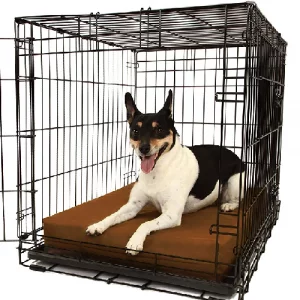
The Big Barker Crate Pad is a good option for those puppies that need more padding to feel comfortable. This crate pad is made in the USA with 4″ Certi-PUR US® certified foam and comes with a removable, washable, waterproof and tear resistant cover. You can find this crate pad at Amazon.com
5. Safety Gates and other ways to limit where they roam
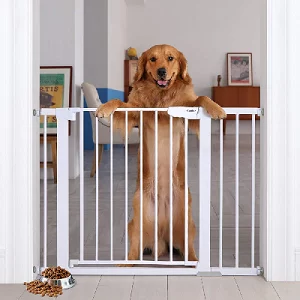
Just like baby’s, puppies are born with an inherent desire to explore their surroundings. This can lead to getting into a lot of trouble. Puppies should never be left alone unless they are secured in a puppy proof location.
To puppy proof your home you will need gates to limit where they can roam and you need to carefully inspect every inch of that space for hazards like electrical cords and poisonous plants. Read Puppy Proofing Your Home – 10 Silent Dangers to get tips on what you need to look for.
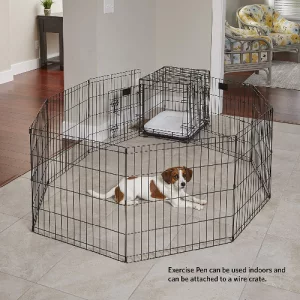
If you live in an open concept home gates will not work for you. Another option is the Midwest Foldable Metal Exercise pen that can be connected to a Midwest crate. The combination creates a safe place for your puppy when you can’t watch them. The Midwest Foldable Metal Exercise pen is available at Amazon.com.
Another option is the Lucidium Modern Dog Pen. This modern pen is an aesthetically pleasing option for securing your pet, and they provide a “cage-free” environment in your home. You can find it on Etsy.com
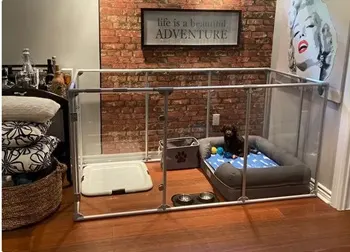
6. Collar And Leash
When you first bring your puppy home you will need a collar and leash. For most puppies they will grow out of their first collar by the time they are a year old. If you have a larger breed dog, you might need to replace their collar a few times as they grow.
A simple collar and 6 foot leash is all you need to begin training your pup to walk on a leash and to start potty training. For training purposes I do not recommend a retractable leash as they can easily get tangled.
Determining the right size collar
It is important to have the right size collar for your pup. Too small and it will be uncomfortable. Too big and they can slip out of it, possibly running off. Here is the general guideline to determine the correct sized collar.
- Using a flexible measuring tape, measure around your puppy’s neck. The measuring tape should be snug against their skin but not tight. You can also use a piece of string or ribbon and then measure the length by using a ruler.
- Next add two inches to the length. This should allow enough room to be comfortable for your pup without them being able to slip out of their collar.
- Once you get the collar, you need to try it on your pup. See if you can slip two fingers under the collar. With the width of your two fingers between the collar and neck, the collar should feel snug, but not tight.
- Now check to see if you can slide your pup’s collar off his head. Unless it is a coke chain you should not be able to slide the collar off. If you can, so can your pup.
Other considerations when selecting a collar:
- The width of your dog’s collar is just as important as the length. A collar that is too wide may rub and cause discomfort. While a collar that is too narrow may cause too much pressure on one area of your pup’s neck. Especially, when they are on a leash. Typically the width of a collar is determined by the length, but this might not always be the case. Watch your pup. If they continue trying to get the collar off it could be because it is uncomfortable.
- Lastly, check the fit of the collar at least once a month. More if they are growing quickly. Continue to do monthly checks until your pup is fully grown to make sure it fits properly. Even after that you should check the collar periodically to ensure it is not worn or damaged and still fits correctly.
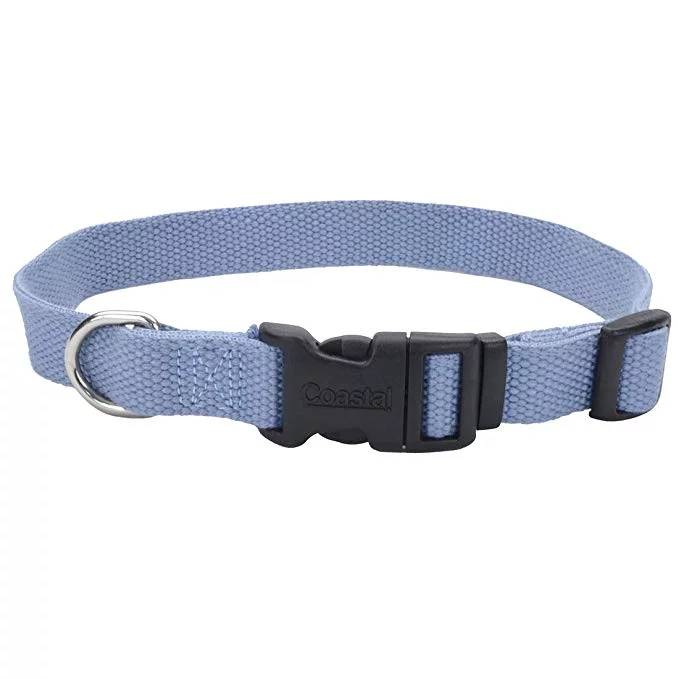
We got our puppy the New Earth® Soy Adjustable Dog Collar shown above. Five years later she is still wearing it. Made of natural soy fibers, these durable, earth-friendly collars have a soft feel perfect for puppies. Available in seven earth-friendly colors using all-natural dyes. The New Earth® Soy Adjustable Dog Collar and the matching lead is available at Amazon.com.
Choosing a Dog Harness
Although I highly recommend using a collar to keep your puppy’s ID and Rabies tags, you should use a dog harness to walk your puppy. A dog harness has a number of benefits over dog collars:
- A collar can hurt the neck of a puppy that is pulling on the leash
- A harness distributes the pressure, caused by pulling, along the chest instead of the neck
- It is much harder for a dog to wiggle their way out of a harness
- A harness will offer better control over a puppy that is pulling on their leash
There are a number of different types of harness on the market. We have an Earth Soy Dog Comfort Wrap Harness. Made from the same materials as the Earth Soy Collar. The soft harness is also a great choice for puppies. The Earth Soy Dog Comfort Wrap Harness can be found at Amazon.com.
Puppy ID Tag
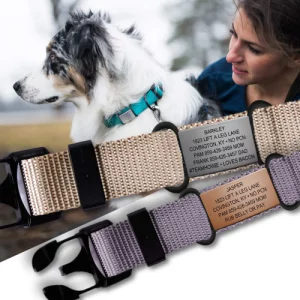
To help find a lost puppy, every dog should have an ID Tag. The Road iD personalized tag which can be found on Amazon.com is jingle free. A great choice for a puppy that might be distracted by the sound and movement. The low profile reduces the chance of the tag being snagged on a bush or by another dog.
7. Toys
Toys are essential for puppies as they provide mental stimulation, aid in teething relief, encourage physical exercise, and assist in training and socialization. The best toys for puppies include chew toys for teething relief, interactive toys for mental engagement, plush toys for comfort, tug toys for interactive play, and balls or fetch toys for physical activity. It’s important to choose toys that are appropriate for your puppy’s size and ensure they are safe and durable.
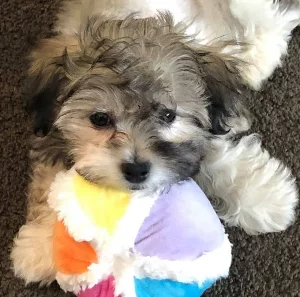
When selecting a toy for your puppy, look for one that is soft and flexible. Hard toys can hurt your puppy’s gums and possibly damage new teeth. We gave our pup a Hugglehounds soft chicken. Like the one shown below. It was her favorite toy. She carried it around everywhere when she was a puppy. This one is for aggressive chews, but they do wear out over time.

Just remember no toy is indestructible. Puppies should be supervised when playing with any toys to prevent injury.
Non-Essential Items that make life easier
8. Snuggle Puppy Heartbeat Stuffed Toy
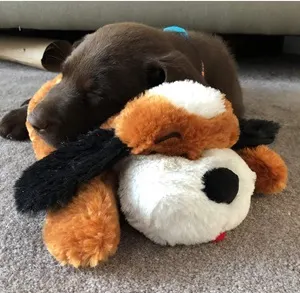
The SmartPetLove Original Snuggle Puppy is a comforting plush toy designed to soothe and calm puppies. It mimics the warmth and heartbeat of another creature, making it especially beneficial for puppies that have just left their mother and littermates. This can help reduce anxiety, loneliness, and sleep issues in young dogs. The toy typically includes a heat pack and a real-feel heartbeat device, providing a sense of security and companionship to your puppy.
Unfortunately we did not know about the Snuggle Puppy Heart when we brought home our puppy, but we have heard many good things about it from people who have used it. You can find it at Chewy.com, Pet Smart and Amazon.com
9. Food Mats
Although not a necessity, food mats make feeding time easier. A good quality food mat will prevent your dog’s bowls from moving around and keep spills contained. When choosing a food mat, pick one with a rubber bottom to keep it from sliding and a lip to keep spilled liquids from reaching your floor. There are many different types and sizes of food mats available.
Bringing Home Your Puppy
As you get ready to bring your new puppy home, it’s time to think about the key questions to ask your breeder. These questions should cover the puppy’s health history, its daily routine including feeding and sleeping schedules, and any other details that will aid in a smooth transition for your new pet. For a helpful guide on what to ask, check out our post 30 Questions To Ask A Breeder When Picking Up A Puppy.
You will also want to prepare your home to your puppy’s arrival. This means puppy proofing your home. In our post Puppy Proofing Your Home – 10 Silent Dangers, we go over some of the items you may not think about.
For more tips on caring for your new puppy, check out my other posts:

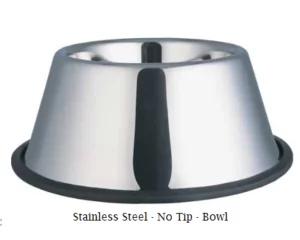
Margo
Friday 21st of August 2020
I have been blessed with 39 years of rescuing dogs. I rescued a poodle doodle and and now would like to adopt a puppy -poodle doodle. Thank you. We live near the beach.
Bonnie
Saturday 22nd of August 2020
It's so wonderful that you have had rescue dogs for 39 years.
Good luck finding your poodle doodle. Petfinder.com was a great resource for us when we were looking for a poodle crossbreed to adopt.
If you like this posts, please check out some of our other posts on puppy training.